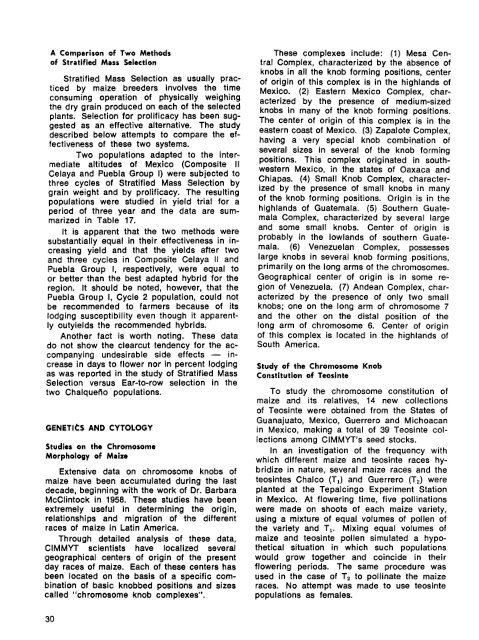REPORT - Search CIMMYT repository
REPORT - Search CIMMYT repository
REPORT - Search CIMMYT repository
Create successful ePaper yourself
Turn your PDF publications into a flip-book with our unique Google optimized e-Paper software.
A Comparisonof of Two Methods<br />
of of Stratified Mass Selection<br />
Stratified Mass Selection as as usually practiced<br />
by by maize breeders involves the time<br />
consuming operation of of physically weighing<br />
the dry grain producedon on eachof of the selected<br />
plants.<br />
Selection for prolificacy has been suggested<br />
as as an an effective alternative.<br />
The study<br />
described below attempts to to compare the effectiveness<br />
of of these two systems.<br />
Two populations adapted to to the inter<br />
inter~<br />
mediate altitudes of of Mexico (Composite II II<br />
Celaya and Puebla GroupI) I) were subjectedtoto<br />
three cycles of of Stratified Mass Selection by by<br />
grain weight and by prolificacy.<br />
The resulting<br />
populations were studied in in yield trial for a<br />
period of of three year and the data are summarized<br />
in in Table 17.<br />
It It is is apparent that the two methods were<br />
substantially equal in in their effectivenessinin increasing<br />
yield and that the yields after two<br />
and three cycles in in Composite Celaya II II<br />
and<br />
Puebla Group I, I, respectively, were equal to to<br />
or or better than the best adapted hybrid for the<br />
region. It It should be be noted, however, that the<br />
Puebla GroupI, I, Cycle22 population, could not<br />
be be recommended to to farmers because of of its its<br />
lodging susceptibility even thoughitit ly ly outyields the recommended hybrids.<br />
Another fact is is worth noting. These data<br />
do not show the clearcut tendency for the accompanying<br />
undesirable side effects -- in<br />
increaseinin<br />
daystoto flower norinin percent lodging<br />
apparent<br />
as as was reportedinin the studyof of Stratified Mass<br />
Selection versus Ear-to-row selection in in the<br />
two Chalquerio populations.<br />
GENETICS AND CYTOLOGY<br />
Studieson on the Chromosome<br />
Morphologyof of Maize<br />
Extensive data on on chromosome knobs of of<br />
maize have been accumulated during the last<br />
decade, beginning with the workof of Dr. Barbara<br />
McClintockinin 1958.<br />
These studies have been<br />
extremely useful in in determining the origin,<br />
relationships and migration of of the different<br />
racesof of maizeinin Latin America.<br />
Through detailed analysis of of these data,<br />
<strong>CIMMYT</strong> scientists have localized several<br />
geographical centers of of origin of of the present<br />
day racesof of maize.<br />
Eachof of these centers has<br />
been located on on the basis of of aa specific combinationof<br />
of basic knobbed positions and sizes<br />
called "chromosome knob complexes".<br />
These complexes include: (1) (1) Mesa Central<br />
Complex, characterizedby by the absenceof<br />
of<br />
knobsininall all the knob forming positions, center<br />
of of originof of this complexisisinin the highlandsof<br />
of<br />
Mexico. (2) Eastern Mexico Complex, characterized<br />
by by the presence of of medium-sized<br />
knobs in in manyof of the knob forming positions.<br />
The centerof of origin of of this complex is is in in the<br />
eastern coastof of Mexico. (3) Zapalote Complex,<br />
having a very special knob combination of of<br />
several sizes in in several of of the knob forming<br />
positions. This complex originated in in southwestern<br />
Mexico, in in the states of of Oaxaca and<br />
Chiapas.<br />
(4) Small Knob Complex, characterized<br />
by the presence of of small knobs in in many<br />
of of the knob forming positions.<br />
Originisisinin the<br />
highlands of of Guatemala. (5) (5) Southern Guatemala<br />
Complex, characterized by by several large<br />
and some small knobs. Center of of origin is is<br />
probably in in the lowlands of of southern Guatemala.<br />
(6) (6) Venezuelan Complex, possesses<br />
large knobsinin several knob forming positions,<br />
primarilyon on the long armsof of the chromosomes.<br />
Geographical center of of origin is is in in some<br />
regionof<br />
of Venezuela.<br />
(7) Andean Complex, characterized<br />
by by the presence of of only two small<br />
knobs; oneon on the long armof of chromosome 7<br />
and the other on on the distal position of of the<br />
long arm of of chromosome 6. 6.<br />
Center of of origin<br />
of of this complexisis locatedinin the highlandsof<br />
of<br />
South America.<br />
Studyof of the Chromosome Knob<br />
Constitutionof of Teosinte<br />
To study the chromosome constitution of of<br />
maize and its its relatives, 14 14 new collections<br />
of of Teosinte were obtained from the States of of<br />
Guanajuato, Mexico, Guerrero and Michoacan<br />
in in Mexico, making aa total of of 39 39 Teosinte collections<br />
among <strong>CIMMYT</strong>'s seed stocks.<br />
In In an an investigation of of the frequency with<br />
which different maize and teosinte races hybridizeinin<br />
nature, several maize races and the<br />
teosintes Chalco (Td and Guerrero (T2)<br />
2 )<br />
were<br />
planted at at the Tepalcingo Experiment Station<br />
in in Mexico. At At flowering time, five pollinations<br />
were made on on shoots of of each maize variety,<br />
using aa mixtureof of equal volumesof of pollenof<br />
of<br />
the variety and Tlo T i • Mixing equal volumes of of<br />
maize and teosinte pollen simulated aa hypothetical<br />
situation in in which such populations<br />
would grow together and coincide in in their<br />
flowering periods. The same procedure was<br />
used in in the case of of T 2 2 to to pollinate the maize<br />
races.<br />
No attempt was made to to use teosinte<br />
populations as as females.<br />
30 30

















